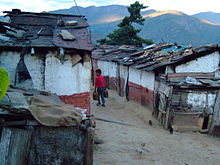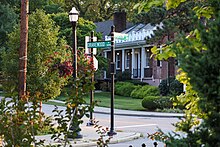Residential area
The topic of this article may not meet Wikipedia's general notability guideline. (October 2022) |



A residential area is a land used in which
Housing may vary significantly between, and through, residential areas. These include
Overview

In certain residential areas, especially
Residential areas may be subcategorized in the concentric zone model and other schemes of urban geography.
Residential development



History
Residential development is real estate development for residential purposes. Some such developments are called a subdivision, when the land is divided into lots with houses constructed on each lot. Such developments became common during the late nineteenth century, particularly in the form of streetcar suburbs.
In previous centuries, residential development was mainly of two kinds. Rich people bought a townlot, hired an architect and/or contractor, and built a

As with other products,
Today, a typical residential development in the United States might include
Problems with residential developments
Criticisms of residential developments may include the following:
- They do not mesh well with the greater community. Some are isolated, with only one entrance, or otherwise connected with the rest of the community in few ways.
- Being commuter towns, they serve no more purpose for the greater community than other specialized settlements do and thus require residents to go to the greater community for commercial or other purposes, whereas mixed-use developments provide for commerce and other activities, so residents need not go as often to the greater community.
- Lodging advancements can frequently be isolated with only one way in and one way out. Without great streets and ways to different regions, getting around can take a pointlessly lengthy timespan - making it harder for individuals to walk and cycle.
- Front nurseries with low walls will quite often be very much taken care of, with inhabitants keeping an eye on their front nurseries and covertly attempting to outperform their neighbors. Numerous designers lessen costs by eliminating these unobtrusive yet significant qualifications among public and confidential space. The outcome is many times puts that become unused, disliked and neglected.
- Current roads are packed with unattended vehicles, which is not just unattractive but blocks pavements, makes roads more unsafe for kids and is also often the source of arguments with neighbours.
- Everybody cherishes a tree-lined road, however new improvements frequently overlook them. Numerous expressways specialists deter trees and hedgerows making green and verdant roads progressively difficult to come by. As an outcome, many modern developments are dominated by hard materials and often appear colorless.
References
- ^ Santiago, Jolie (March 7, 2024). "Bobcat tracks spotted in residential neighborhood". www.wwnytv.com.
- ^ DeParle, Jason; Altman, Bobby (March 1, 2024). "Developers Got Backing for Affordable Housing. Then the Neighborhood Found Out" – via NYTimes.com.
- ^ "New Shwapno outlet opens in Bashundhara residential area". The Business Standard. December 28, 2023.
- ^ "Watch: 4 leopards spotted roaming in Maharashtra residential area". India Today.
- ^ Israeli attack on residential area in south Gaza kills at least 29 people
External links
![]() The dictionary definition of residential at Wiktionary
The dictionary definition of residential at Wiktionary
- Meadowbrook symbol of postwar housing boom - Pantagraph (Bloomington, Illinois newspaper)
